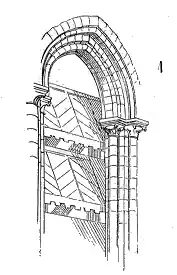Abat-son
An abat-son (plural usually abat-sons) is an architectural device constructed to reflect or direct sound in a particular direction. It consists of large louvers. The term is commonly used to refer to angled louvers in a bell tower or belfry designed to redirect sound or to prevent ingress of water.[1]

Illustration of an abat-son
Abat-son can also mean a louver or board used in the device.[2][3] These boards or sheets are typically made of wood or metal.[4]
The term comes from the French term of the same name, which literally means "to strike down" (abat) the "sound" (son) or "sounds" (sons).[5][6]
Gallery
.JPG.webp) A church in Trélissac
A church in Trélissac Church of Saints Peter and Paul, La Tour-Blanche
Church of Saints Peter and Paul, La Tour-Blanche Church of Our Lady of the Assumption, Échourgnac
Church of Our Lady of the Assumption, Échourgnac
References
- Curl, James Stevens, 1937- (2015). The Oxford dictionary of architecture. Wilson, Susan (Historian) (Third ed.). [Oxford]. ISBN 978-0-19-175298-8. OCLC 913074935.CS1 maint: multiple names: authors list (link)
- Bond, Francis. An Introduction to English Church Architecture from the Eleventh to the Sixteenth Century. London: H. Milford, 1913. Print.
- Montague, Don (2003-09-02). "Dictionary of Building and Civil Engineering". doi:10.4324/9780203475430. Cite journal requires
|journal=(help) - Ph.D, Maxim Newmark (1950-01-15). Dictionary of Foreign Words and Phrases. Rowman & Littlefield. ISBN 978-1-4422-3401-7.
- "Definition of ABAT-SONS". www.merriam-webster.com. Retrieved 2020-12-15.
- Passy, Paul; Hempl, George (1904). International French-English and English-French Dictionary. Hinds, Noble & Eldredge.
Further reading
- Sturgis, Russell, et al., eds. (1902) "Abat-Sons". Dictionary of Architecture. Reprinted 1989 as Sturgis' Illustrated Dictionary of Architecture and Building Vol. I A–E. New York: Dover Publications. ISBN 0-486-26025-9.
External links
 Media related to Abat-sons at Wikimedia Commons
Media related to Abat-sons at Wikimedia Commons
This article is issued from Wikipedia. The text is licensed under Creative Commons - Attribution - Sharealike. Additional terms may apply for the media files.